Roland-Garros 2023: FFT and HBS on this year’s social media proof of concept service, enhanced content and constant learnings
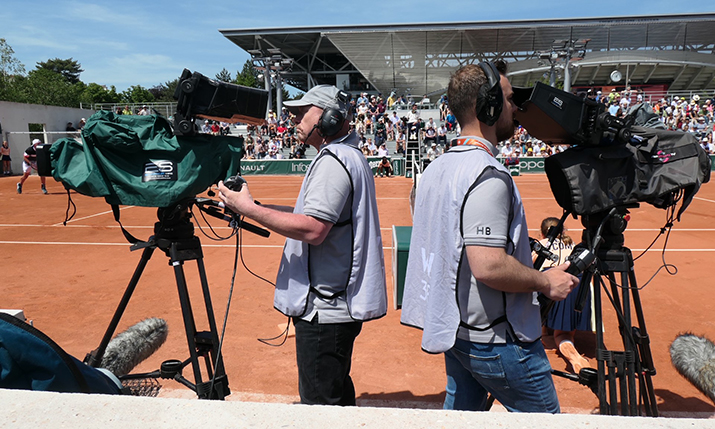
Host court side cameras on Court 6 at Roland-Garros
Roland-Garros is ready for the final call of “game, set and match” this weekend, as the tension builds towards the champions battling it out on the red clay courts.
Following the Fédération Française de Tennis’ (FFT) takeover of the host broadcast from France Television in 2021, its relationship with technical services provider for the annual production of the French Open, HBS, is going from strength to strength.
Speaking to SVG Europe, Amandine Tyl, head of broadcast and production in the media and production department at the FFT, comments on the French Tennis Federation’s goals for the production of Roland-Garros: “From the FFT side, what we are expecting is just to fit with the needs of our broadcasters. We have many different broadcasters around the world; some of them are mainstream broadcasters, others are more like sports broadcasters, and other of them such as Tennis Channel, for example, are dedicated to only tennis all year long. So what we are expecting is to find the right balance in term of broadcasting.
“Between the tennis, which is the core of what we are producing, and the fact that we are Roland-Garros, we are in Paris, and so we also want to show that,” notes Tyl. “So we are focusing of course on the coverage of the courts, which is the basic we need to have for our broadcasters. But as we said, we are also trying to give an overview and make it possible for broadcasters and the audience all around the world to understand where we are; the fact that we are actually in Paris, in the middle of the city, more or less.”
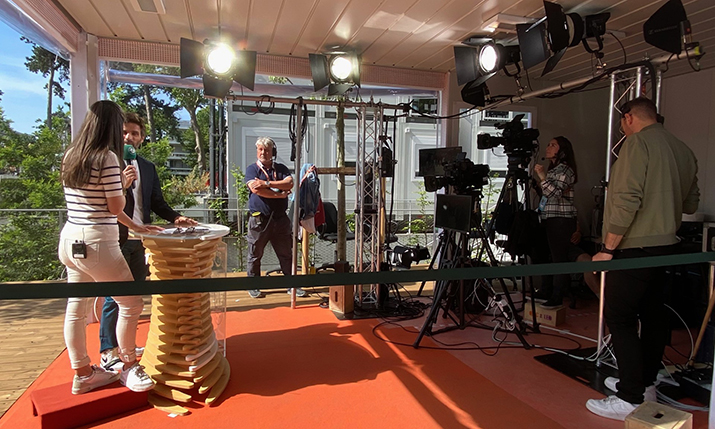
Amazon Prime presentation position at Roland-Garros 2023
Social stories
Social media is the big story of Roland-Garros 2023, where a proof of concept service has been launched this year for all broadcasters to access. Tyl explains: “[Our social media strategy] is evolving a lot. This year as a proof of concept, we have launched a new service for broadcasters together with HBS. It’s called the Social Media Interface. Basically this is a web-based interface which is developed by HBS and on this platform we provide to all our broadcasters only content dedicated to digital platforms, which means content here is really made for digital, not coming [direct] from the world feed. Some of it may come from the world feed, but then it is released in a format which fits with digital needs.
“Also, most of this [social media-specific] content is coming from cell phones,” she continues. “So this is not normal broadcast; this is really something dedicated to digital teams. We have been in touch with all broadcasters, with their digital teams, in order to present the service to explain a little more about what we will share with them. We get the content really quickly; basically those guys [working on this content] are, for example, on the court with their cell phone. They’re just shooting something, they send it immediately, and less than one minute later the broadcaster can get access to this content. They can easily download it. They can change the titles if they want in order to put them on the digital platform.
“This is something that we think is really changing now; that’s the reason why we decided to go for this proof of concept together with the broadcasters, to learn a little more about their needs, and what they really expect from us.”
The FFT launched its main content hub for all its rights holding broadcasters, both on and off site, in 2021. It is called the RG Live Server. The type of content covered on the new Social Media Interface includes classic court content, but also, says Tyl, a lot of behind the scenes footage, such as players just before they enter a court, arriving at the venue in their cars, walking to their practice sessions or in the gym, and so on.
Adds Tyl: “We are trying to put some content, for instance focused on court and what is happening there with a specific digital angle, as well as some behind the scenes content. This is proof of concept so we should be able to tell you later after the tournament how successful it was, but honestly, the first feedback we got are very good. All the broadcasters involved are quite happy with this proof of concept, and the fact that we are trying to give them specific content for their digital platforms. It seems that we have quite a lot of downloads on our platform already, so we will see for next year what we will decide to go for, but this is something we are working on clearly.”
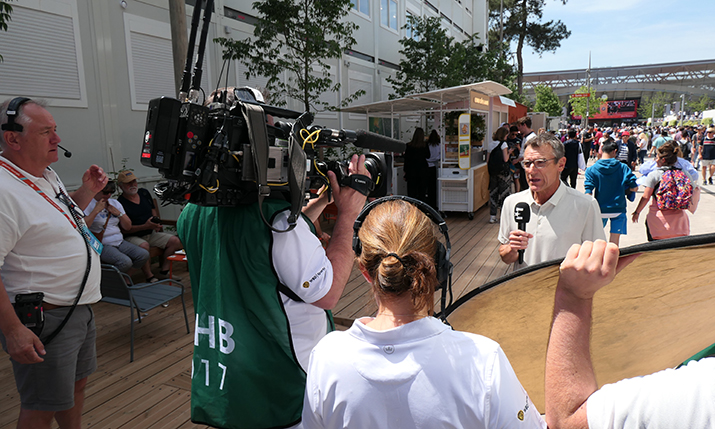
Eurosport roving presentation during French Open coverage this year
Market trends
The FFT decided to create the Social Media Interface proof of concept itself, partly through observing market trends, and partly through watching what its rights holding broadcasters were doing with the world feed content provided in recent years.
Notes Tyl: “We are just following the market. We understand that broadcasters need more and more content for their digital platforms. To be honest, we are quite lucky at Roland-Garros because most of our broadcasters are on site, which is not the case for all events, but still there are some broadcasters who are not on site who don’t have any ENG crew and just rely on us in order to give them [all of their] content. I think [the social media hub] is something quite new. Now, through the social media interface, we have two platforms [including the RG Live Server] which are really easy to use for broadcasters, on which they can get content as if they were in Paris. I think this is something that is really key for us; to make sure that all our broadcasters, even if they don’t have on onsite facilities, can get access to more content.”
Social media reach is also key for the FFT in order to bring in a new generation of tennis fans, who due to the viewing habits of that demographic may not be watching linear TV. Explains Tyl: “Of course this is key for tennis and for the French Tennis Federation because we know that the young generation is consuming less and less [traditional] TV, and more and more on digital platforms. If we want to renew our audience, we also need to be able to get access to those people. This has to be really short content, less than 10 seconds [in length] content, really ready to use for digital platforms like Instagram, TikTok and so on. So this is something we think is important for broadcasters of course because we know this is something they need, but also for FFT ourselves in order to renew our audience and make sure that we can speak to those people as well.”
She continues: “We need to make sure that we can keep this audience and in order to keep it, we need to be able to speak to the young generation as well. They are consuming content differently and we need to get used to this. We know that tennis can be very long; I mean we can have four or five hour matches. We know that the young generation almost never stick to a programme from the very beginning to the end so we need to develop the appetite for such content as tennis.”
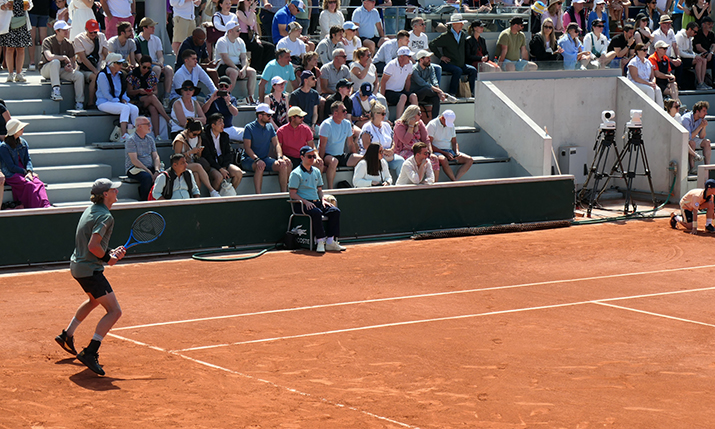
Remote PTZ cameras in action on an outer court at the French Open 2023
Enhanced content
To enhance that content, for the first time in 2023 viewers have been able to view Roland-Garros from the sky, as well as many iconic views of the city itself. Explains Tyl: “This year we have introduced a drone. We have drone shooting during the 15 days of the main draw. So we have a drone shooting all day long from 10 in the morning till 10 at night in order to give an overview of the venue itself, to show the venue [in situ] next to Paris, to the Eiffel Tower, but also to show the venue itself. We have invested quite a lot of money in our venue and we are very proud of what we did so we want to be able to show it to all broadcasters; everyone on the earth needs to know exactly how Roland-Garros looks like now! It’s very different from what it used to be in the past. So the drone is one of our ideas to show and enhance the venue a little more.
“It also gives us an opportunity to have different views of the courts,” Tyl continues. “So the drone we have this year has three different optics, so it makes it possible to overlook onto Court Philippe-Chatrier for example, but also on Court Simonne Mathieu and all the other courts of the venue.
“The coverage of the court, what is happening on court making sure that we don’t miss anything is key,” she notes. “But also being able to enhance the coverage through those kinds of beauty cameras. We have also quite a lot of beauty cams to show the venue inside Paris.”
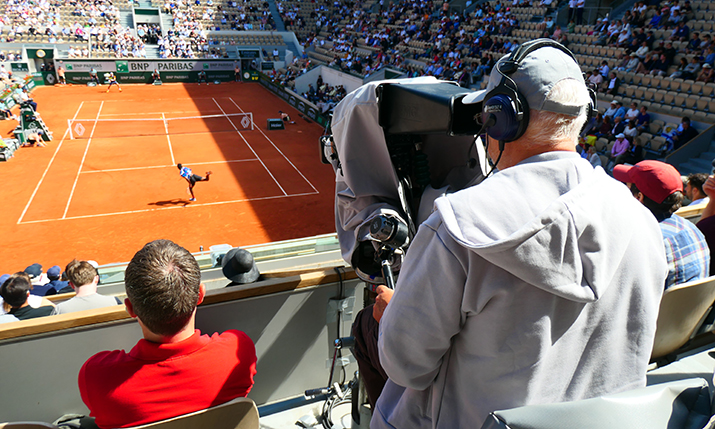
Main match camera on Court Suzanne Lenglen at Roland-Garros
Constant learning
Both the FFT and HBS learned a lot last year, as crowds returned to the venue and further enhancements were rolled out for the production. That knowledge is shaping how things are being done at Roland-Garros today.
Philippe Oziol, director of HBS France Production, says: “There was quite a lot of things that we learned last year. Because last year it was the first full year as such, because the year before there was still the COVID thing, while last year it was more open; it was crazy, the number of people that were on site.
“And as Amandine said, we also want people who don’t have the possibility to come to Roland-Garros to experience the uniqueness of the venue. So we changed the position of the beauty cameras to enhance the stadium quite a lot.”
However, the key learning was about the full IP-based network that HBS used for Roland-Garros in 2022, states Oziol. “We learned a lot last year because it was the first time that we had a full IP broadcast solution. It has been a huge learning curve because it’s clearly something quite new in this industry.”
Oziol comments on the particularities of the full IP-based network launched last year. “Compared to an SDI system, now you can have all the different sources and you can organise and distribute them remotely, which changes the way you work. It also changes the kind of profiles that you work with,” he says, referring to the operators needed to control an IP network. “It’s an engineering-based technology. Everyone, when you have a change, you need to learn about it, to have a different skills. And it clearly doesn’t require the same skills everywhere.”
Elsewhere, HBS also added a further court to its remote production this year, taking the total being produced in the north of Paris to 13, while the production for the main four courts remains on site.
The four main courts are being produced in full IP ST 2110-20/30 UHD HDR production workflow, while the additional courts are being covered with a full remote 1080pSDR production workflow, with four cameras per court on an all-in-one production set up.
The Master Control Room is overseeing and guaranteeing the distribution of a total of 138 feeds including UHD HDR, 1080pSDR and 1080iSDR.
There are a total of 120 cameras within the whole Roland-Garros site, all of which are Sony Global shutter cameras. All 120 cameras are shaded and supervised within one single, centralised gallery overseen by two senior supervisors.
Oziol notes: “We have a lot of different signals that we distribute to broadcasters as well with different formats, and that’s something that we work on closely with FFT. Different broadcasters all have different needs especially now when we speak about broadcasters that are not only linear, but offer OTT distribution. For a platform like Amazon, we need to provide them with what is relevant for them, which is slightly different.”
On the topic of audio, Oziol says for Roland-Garros 2023, microphones have been shifted in position and their numbers increased, with the addition of umpire mics, to allow viewers at home to become more immersed in the action.
He says: “We have put microphones at the ground level [on the courts] which allows us to have a better sound of the players; [this low mic] allows us to hear the clay, when there is a slide on the clay. And on top of it as well, with the support of the FFT, we have the referee microphone, meaning that we can hear everything that he is sharing with the players. And more specifically, at the beginning of the match, he recaps the rules and so on. Now we have a clear sound of what is going on. That’s really a huge enhancement.”
This year there are a total of 220 mics across whole Roland Garros site. There is an audio mix with MCIS 5.1 on courts Philippe-Chatrier, Suzanne Lenglen and Simonne Mathieu. All the other courts are on a stereo mix. There is also a centralised intercom system including RF and wired devices. There is also full RF coverage of the whole Roland Garros site for 12 RF cameras and 120 Riedel Bolero units.
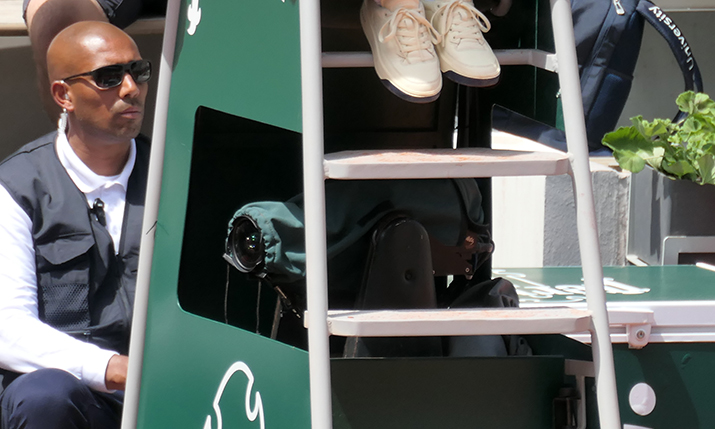
Umpire chair remote camera on Court Suzanne Lenglen
Change is coming
As for the future, there will continue to be change for the host broadcast of Roland-Garros over coming years, confirms Tyl, who states: “We have a level of broadcast which is really at the level of high international sports events now. But of course we will consider new things with HBS for sure, because we would like to do something different from one year to another.”
“For sure,” agrees Oziol. “What we want is to bring something where there is more visibility for the content, and for what you can get around it. We’re doing things because we want to fit the need of the broadcasters, and clearly we need their feedback as well to see what they like, and what was maybe less effective for them.”
“It’s how we work and how we want to continue to enrich things. But especially on format and so on, I think that already Roland-Garros is one of the highest quality formats,” Oziol concludes.
Watch the final matches of Roland-Garros this weekend, 10 to 11 June 2023

